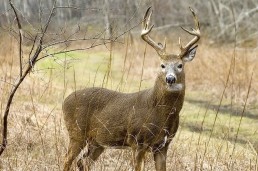Of Spikes and Monster Bucks
SHARE THIS POST
Are spike bucks made from inferior genetics?
In deer hunting circles, especially deer camps, it’s easy to find people who believe that spike bucks possess inferior genetics. That was the belief of researchers until fairly recent times, in fact. One of the first to dig in and find that it was likely not true was longtime MidWest Outdoors writer Dr. Ken Nordberg.
Here is a short excerpt from the upcoming cover feature in the November issue of MidWest Outdoors, Ken Nordberg In his own Words…
MidWest Outdoors: You started your research on whitetail deer in 1970. What was the first thing you studied?
Dr. Ken Nordberg: “One of the first things I set out to study, using scientific methods, was to look into why we had so many spike bucks in the area we hunted in Aitken County. We set up a study area and started providing cattle-type mineral blocks to the deer in a two-square-mile area, and not to the deer in another two-square mile area.
Before long, after a few years, we found that not only did we rarely have a spike buck in the treated area, but we had better fawn survival, compared to the untreated area. What it meant was that our deer were not getting enough calcium, phosphorous, zinc, and other minerals it takes to create the bony antlers.
After these deer started getting mineral blocks, we had 8-pointers as yearlings. Little basket-type antlers, but what a difference it made. Back then, they were saying, “it’s good to shoot all the spikes; get them out of the population, it’s a genetic deficiency.” Those bucks were as good as all the other bucks; they just didn’t get enough of these important minerals.”
Corroborating Research
Many others, including Dr. Mickey Hellickson, chief wildlife biologist at the sprawling King Ranch in south Texas, are confident that spikes can become monster bucks when they mature.
On a study area of 825,000 acres, Dr. Hellickson and Texas Parks & Wildlife Department researchers spent 8 years studying impact of harvest goals on quality of deer racks.
Are you enjoying this post?
You can be among the first to get the latest info on where to go, what to use and how to use it!
To test whether limiting buck harvest to animals with smaller antlers (known as ‘management’ bucks, or ‘cull’ bucks) results in more trophy bucks, they undertook the ambitious “South Texas Buck Capture Project.” More than 4,000 bucks were captured in net-guns, tagged, aged, released, and captured again for follow-up study.
The result, when data were analyzed?
“Over 8 years of very intensive culling,” wrote Dr. Hellickson, “we weren’t able to show any benefits in terms of improvement in antler quality.”
So, it would seem, genetics plays little, if any, part in determining whether a given buck will produce trophy antlers. Nordberg’s work has also been reinforced by developers of deer nutritional products, notably a Cargill subsidiary, Sportsman’s Choice. You can read about providing essential nutrition to your local deer herd, in a free pdf report at: free report on deer nutrition.
(Full disclosure: Sportsman’s Choice is a MidWest Outdoors advertiser.)
In “Chemistry for Quality Bucks,” noted author Charles J. Alsheimer answers the question, “What components are necessary to produce quality whitetail bucks?” this way…
“Age, genetics, good nutrition, and herd management. Of the four ingredients, age and nutrition are the most important. Once bucks reach maturity, ‘they are what they eat’ in most instances, so the two go together like hand and glove.”
Bottom line, for hunters: give spike bucks a chance to grow up, if you hope to shoot a trophy. But don’t shoot spikes in order to improve the genetic makeup of your local deer population. Spike bucks are trophies to many hunters, especially newcomers, so keep that in mind as you comment on other people’s kills. If you want to improve the health of local deer, and your chances of seeing bigger antlers, consider feeding them high quality nutritional supplements. That seems to be the answer to quality deer management, including for breeding does.
MWO
SHARE THIS POST
You may also like...
Nothing found.
Did you enjoy this post?
You can be among the first to get the latest info on where to go, what to use and how to use it!
Mark Strand
MidWest Outdoors editorial director Mark Strand is a graduate of University of Minnesota School of Journalism with a minor in Fisheries & Wildlife Science. He has written for nearly every outdoor magazine over the past 41 years, and has written or co-written 14 books. In addition to writing and photography, Strand produces the MidWest Outdoors Podcast, and contributes to MWO digital properties. He is an outdoor generalist who loves hunting and fishing of all types. In 2018 Strand was elected to the Minnesota Fishing Hall of Fame.
